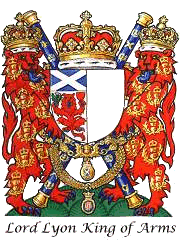Researched and compiled by
Hugh D.P. McArthur, FSA Scot
Clan Arthur Seannachie
High Commissioner for Clan Arthur in Britain
© 2020 Hugh DP McArthur

Photograph by
Hugh DP McArthur
Saint Blaan (or Blane) is a somewhat furtive figure in Scottish history. He was born on the Clyde island of Bute, the illegitimate (so folklore says) son of Aedan MacGabhran, King of Scots, and Ertha (sister of Saint Cattan). This relationship makes Blaan half brother to Artur MacAedan.
Blaan's origins are similar to Saint Kentigern's, in that he was set adrift on the seas in a coracle with his mother soon after his birth - They landed in Ireland. When the boy was seven, they returned to Bute where Blaan was tutored by his Uncle Cattan, who was also of Royal Dalriadic descent.
Ordained into the priesthood of the Celtic Church by his uncle, Blaan founded his chapel and monastery on the south end of the island adjacent to an older Pagan site known as the Cauldron. His influence was strong ~ It was not until 1661 that the practice of segregated burials, men in the upper graveyard women in the lower, was abolished in Blaan’s churchyard. Remarkably the name Bute is derived from the Gaelic bod meaning penis, illustrating strong masculinity within the island’s landscape. Our ancestors were not prudish ~ They named what they saw.
Summoned to Rome, Blaan was anointed Bishop by the Pope ~ The Catholic Encycolopedia describes him as Bishop and Confessor in Scotland ~ Blaan returned home to Bute again. There is a church of Saint Blane in Dumfries and there is a dedication to Saint Blane just east of Helensburgh at Camus Eskin. Kilblaan (The Church of Blaan) adjacent to the Kilblaan Burn, can be found in Glen Shira, just north of Inveraray, on the ancient pilgrimage route to Iona. He undoubtedly left his name on Blantyre (Blaan’s Land) high on the southern flank of the Clyde Valley and he is remembered in Blanefield, Strathblane and the Blane Water which all lie in the Lennox to the north of Milngavie.
The Blane Water runs through the Arthurian Battlefield of Ardinning, 570AD (see Artur & Aeden) . The Law of the Innocents was not written until over a hundred years after Ardinning, suggesting that clergy could well have been involved with this conflict. Today an ancient Druid’s Stone can still be observed within the kirkyard of Strathblane Parish Church not far from the standing stone that marks the place where the Pagan Angles made their last stand.

Photograph by Hugh DP McArthur
Blaan journeyed further into Central Scotland and founded another monastery in the ancient Celtic tradition of a group of "beehive" cells to the north of Stirling. The strategic site was in Pictland and "guarded" a very important crossing on the River Forth. Today the site is known as Dunblane Cathedral ~ Seat of the Church of Scotland. The original bell from Blaan's monastery on the Isle of Bute is preserved in the Cathedral.
The Saint is accredited with many miracles; bringing a dead boy back to life, lighting tapers with sparks from his fingers and taking steps measuring three leagues! Although it is unknown when he was born, the general agreement is that he died in 590AD, concluding that his life was contemporary with his relatives Columba, Kentigern and Artur MacAeden. King Arthur is often interpreted as a crusading knight at a time when British religion was changing from the old ways. Artur MacAeden's relatives near and far were changing the face and spirit of Northern Britain in the 6th century. Was the historic Artur the power behind the cross?
Blaan was canonised in 1000AD, his feast day is 10th of August.
SELECT BIBLIOGRAPHY:
CATHOLIC ENCYCLOPEDIA: Saint Blaan http://www.newadvent.org/cathen/02594b.htm

